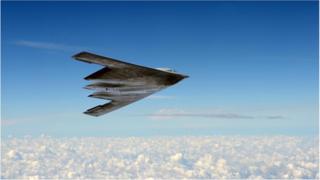INSUBCONTINENT EXCLUSIVE:
Image copyrightUniversity of WaterlooImage caption
Canada is investing $2.7m to develop technology to detect stealth
detection of stealth aircraft.The technology is being developed by the University of Waterloo to replace existing Arctic radar
stations.Quantum radar can theoretically detect objects with a greater level of accuracy than conventional radar.It makes use of quantum
illumination - the process of isolating pairs of entangled photons
So far, the technology has been tested only in laboratories
Canada and the US jointly maintain 54 North Warning System (NWS) radar stations in the Arctic, which act as the first line of early warning
atmospheric air defence for North America.These radar stations are approaching the end of their life spans, and could need to be replaced as
Several other countries are also interested in developing quantum radar, including China and Russia
In November, the Chinese Academy of Sciences, in Shanghai, announced that its scientists were developing a new type of spy satellite that
would be able to "uncover" stealth aircraft.How does quantum illumination workQuantum illumination uses quantum entanglement, a phenomenon
whereby a pair of photons are connected, and even if the photons are separated by a great distance - such as hundreds of miles - actions
performed on one photon continue to affect the other.True quantum entanglement is difficult to maintain for long periods of time, and
computer scientists and quantum physicists continue to puzzle over this problem in order to build quantum computers and make quantum
encryption work.However, even if the pair of photons disconnect - a process known as "decoherence"- they still remain related, which means
they can be used to detect stealth aircraft.Detecting stealth aircraftImagine you're firing out photons in the hope they will hit something
If they bounce back, it tells you there is something there
That's how regular radar works, using microwave signals.Stealth fighter jets and bombers are typically designed to have lots of angles, so
that when a microwave photon bounces towards the body of the aircraft, instead of bouncing straight back to the sender, the photons bounce
off in a different direction.This means that fewer photons return to the detector, which makes the object seem "invisible" on conventional
With quantum radar, you have a pair of entangled photons, and one of the photons gets fired out
It bounces off the hidden object, and because it is entangled, the detector can trace where it went to, and keep firing more photons until a
picture is built up of where the object is in the atmosphere - a bit like a quantum version of the game Battleship
According to quantum computing expert Prof Alan Woodward, of Surrey University, when an entangled photon is fired out, there is a much
higher level of certainty that the photon detected is actually one that you fired, as opposed to other photons that just happened to be
around the aircraft at the time."In theory, entangled photons should be a significant improvement over the results of conventional radar,"
he told the BBC."But we're at a very early stage, and this investment is about seeing whether we can really turn theory into practice."Roger
McDermott, a visiting senior research fellow at the department of war studies at King's College London, said that there were currently no
known electronic warfare technologies capable of unmasking stealth aircraft.Quantum radar could become a viable form of electronic warfare,
he said, but so far, "there is little evidence that it has advanced much beyond the laboratory" in any country
"It needs further research and development, as well as field testing before it reaches a realistic procurement option," he said.Prof
Woodward said that in addition to improving North America's radar defence, Canada has a history of supporting quantum technologies, and
would like to be one of the top countries in the world in this field

